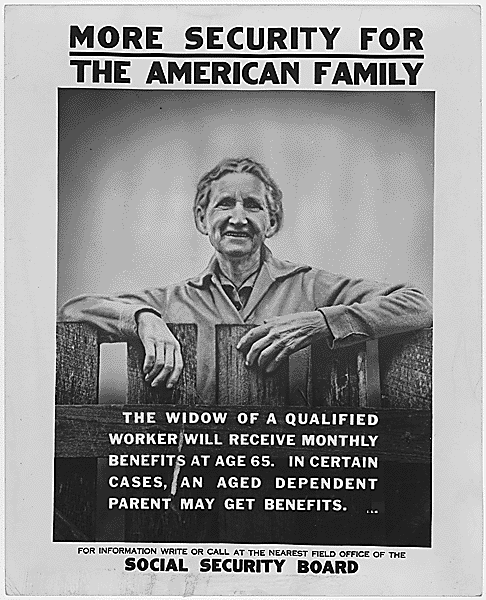FDR AND THE GREAT DEPRESSION
On March 4, 1933, Franklin Delano Roosevelt, the newly elected Democratic president, gave his inaugural speech, in which he projected confidence, hope, and cautious optimism. Yet, the U.S. economy was in the midst of the greatest crisis in the country's history. The banking system was on the verge of total collapse, the unemployment rate reached nearly a quarter of labor force, and farmers were destroying crops after their market value dropped dramatically.
Although during the 1932 presidential campaign Roosevelt had no clear idea what his New Deal agenda would entail, he took over the office ready to act. The New Deal was an unprecedented plan that envisioned large-scale programs and reforms designed to support struggling Americans, boost the economy, and prevent similar disasters in the future. A popular narrative presents the New Deal as a series of programs that responded to the Great Depression with "3 Rs:" relief, recovery, and reform. Relief was direct, immediate support for unemployed and poverty-stricken Americans. Recovery meant bringing the economy back to the level of stability and prosperity. Reform entailed introducing measures that would prevent a similar crisis in the future.
FIRST NEW DEAL (1933-1934/35)
No other president has been able to achieve as much as Roosevelt in his first 100 days of presidency. Nearly all the programs of the first stage of the New Deal were initiated at that time and executed within less than the following two years. Three expert-advisers from Columbia University - Raymond Moley, Rexford Guy Tugwell, and Adolph A. Berle, Jr. - formed Roosevelt's "Brain Trust" and greatly contributed to FDR's initial response to the Great Depression. Although historians label it as the First New Deal, initiatives introduced in the first 100 days of Roosevelt's presidency do not form a unified program. Instead, they were rather a bold response to what many saw as a war-like state of emergency. Some of the most important programs and reforms of the First New Deal were:
- Only 36 hours after taking the presidential oath, Roosevelt closed all the banks (the so-called Bank Holiday). The Emergency Banking Act followed the Proclamation and enabled the government to close weak banks and reopen more stable banks. The initiative helped to rebuild trust in the U.S. banking system. Roosevelt also prohibited the export of gold from the United States and thus took the country off the gold standard.
- The creation of the Agricultural Adjustment Administration (1933). Among many initiatives, AAA provided farm subsidies in exchange for curbed agricultural production (farmers would not cultivate all of the land on their farms) and manipulated farm product prices by buying and temporary withholding products from the market.
- The Tennessee Valley Authority (1933) was the first large-scale public work project, which created short- and long-term jobs by building and operating a hydroelectric project in the valley of the Tennessee River. Public work projects were an essential component of the job creation program under the New Deal.
- National Recovery Administration (1933) allowed industries to create codes that would regulate and curb unfair competition. The Supreme Court declared NRA unconstitutional in 1935.
- Federal Emergency Relief Administration (FERA; initiated by Hoover) created local and state government mostly unskilled jobs.
- The Civilian Conservation Corps (1933) put large numbers of men at work in natural resources projects (e.g., in national forests). The initiative combined conservation effort with creating jobs.
Although this list is not complete, it gives an idea of what kind of initiatives fall under the umbrella of the First New Deal. For the first time in American history, the government was so directly involved in reforming and regulating the economy.
SECOND NEW DEAL (1935-38)
While the Second New Deal was a continuation of the First New Deal, reforms and programs labeled as the Second New Deal were less a result of the earlier sense of emergency and more a reflection of bolder attitudes. The Supreme Court declared some of the First New Deal programs unconstitutional and Roosevelt followed with an agenda that focused more on the question of social justice. He pushed more pro-labor/social reform and anti-business initiatives but historians caution against seeing Roosevelt as anti-capitalist. The New Deal was always about fixing capitalism rather than replacing it with a state-regulated economy. The most important programs of the second stage of the New Deal were:
- The National Labor Relations Act (1933; known also as the Wagner Act), which established the National Labor Relations Board (1935). The NLRA supported the rights of workers to organize and bargain collectively. It also significantly curbed some of the practices that could harm the welfare of workers. The Act remains a groundbreaking statute in the United States labor law.
- The Works Progress Administration (1935) created millions of jobs by employing mostly unskilled men in massive public work projects (building bridges, parks, roads, etc.).
- The Social Security Act (1935) established the welfare system by providing financial support for dependent minors, the disabled, and the elderly (old-age pensions). It also introduced unemployment insurance.
- The Housing Act (1937) provided funds for low-coast public housing for the poorest families.
- The Fair Labor Standards Act (1938) was the first federal law that included a national minimum wage and the forty-hour week as the standard work week.

A poster publicizing Social Security benefits, author unknown, late 1930s/early 1940s